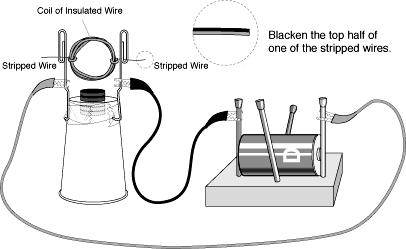
|
|

| A coil of wire becomes an electromagnet when current passes through it. The electromagnet interacts with a permanent magnet, causing the coil to spin. Voila! You have created an electric motor. |
![]()
|
|
(30 minutes or less)

| |
|
Current flows through the wire coil and creates an electromagnet. One face of the coil becomes a north pole, the other a south pole. The permanent magnet attracts its opposite pole on the coil and repels its like pole, causing the coil to spin. Assume that the permanent magnets are mounted with their north poles facing upward. The north pole of the permanent magnet will repel the north pole of the loop electromagnet and attract the south pole. But once the south pole of the loop electromagnet was next to the north pole of the permanent magnet, it would stay there. Any push on the loop would merely set it rocking about this equilibrium position. By painting half of one end black, you prevent current from flowing for half of each spin. The magnetic field of the loop electromagnet is turned off for that half-spin , the paint turns off the electric current. The inertia of the rotating coil carries it through half of a turn, past the insulating paint. When the electric current starts to flow again, the twisting force is in the same direction as it was before. The coil continues to rotate in the same direction. In this motor, the sliding electrical contact between the ends of the coil of wire and the paper clips turns off the current for half of each cycle. Such sliding contacts are known as commutators. |
| ©1997 The Exploratorium 3601 Lyon Street San Francisco, CA 94123 |
|
Follow-up 1. Describe the process that makes the coil spin. 2. Which pole of the loop electromagnet will be repelled by the north pole of the permanent magnet? 3. Why is it so important to paint half of one projecting wire black? 4. Explain why it is important for the electric current to be turned off for a half-spin. 5. The inertia of the rotating coil carries it through half of a turn. What is inertia? Look it up! 6. What is a commutator? What purpose does it serve? |
|
Obtaining credit for your efforts
|